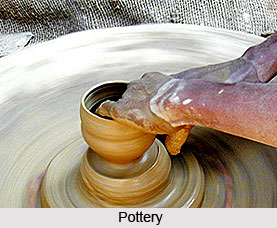 Economy in ancient India was mainly rural and agricultural in nature. The word Pancakrsti literally means either rotation of five crops in the same field or the growing of five kinds of crops in different fields. Other sectors that chiefly contributed to the economy of ancient India included pottery, carpentry, metal-work, glass-work, jewellery making, weaving and leather-work. Besides cultivators, there were the carpenter, goldsmith, weaver, barber, woodcutter, labourer, fighter, dancer, hunter, fowler, beggar, usurer, garland-maker, armour-maker, attendant, merchant, chariot-maker, metal-worker and craftsmen. Vedas, epics and other literary texts of ancient India provide several references to the economy of ancient India. For instance, there are numerous references to agriculture and various crops in the Atharva Veda too. Besides paddy, barley and sugarcane several other agricultural products are evident through the Vedic texts. This Veda also mentions the natural manure of animal. Rig Veda appears to be familiar with irrigation canals and the Atharva Veda describes the excavation of a canal from a river. Their main purpose appeared to be irrigation.
Economy in ancient India was mainly rural and agricultural in nature. The word Pancakrsti literally means either rotation of five crops in the same field or the growing of five kinds of crops in different fields. Other sectors that chiefly contributed to the economy of ancient India included pottery, carpentry, metal-work, glass-work, jewellery making, weaving and leather-work. Besides cultivators, there were the carpenter, goldsmith, weaver, barber, woodcutter, labourer, fighter, dancer, hunter, fowler, beggar, usurer, garland-maker, armour-maker, attendant, merchant, chariot-maker, metal-worker and craftsmen. Vedas, epics and other literary texts of ancient India provide several references to the economy of ancient India. For instance, there are numerous references to agriculture and various crops in the Atharva Veda too. Besides paddy, barley and sugarcane several other agricultural products are evident through the Vedic texts. This Veda also mentions the natural manure of animal. Rig Veda appears to be familiar with irrigation canals and the Atharva Veda describes the excavation of a canal from a river. Their main purpose appeared to be irrigation.
In the age of Brahmanas too agriculture was the principal occupation. The Shatapatha Brahmana mentions the different agricultural operations, such as ploughing, tilling, sowing, reaping, threshing etc. In a society, which was mainly agricultural and pastoral, huge significance was attached to cattle. Moreover, in several places of Shatapatha Brahmana, cattle are stated to be the source of prosperity, goods, riches, food and even of home. Further, cattle-rearing also contributed to the economy of ancient India. It was an essential occupation in such a society. Domesticated animals were known as gramya (rural). In the age of Brahmanas, various other occupations arose to suit the needs of mixed castes. Kshatriyas were mainly engaged in the army. Trade, commerce and agriculture were the occupations of Vaishyas. Service of the upper classes was the livelihood of Sudras.
 Ancient Indian economy also included crafts making. It was another popular occupation that included making of toys like the elephant, glass-work, weaving, making gold ornaments, etc. Among women, the common occupations were weaving, knitting, sewing and embroidery. Mat making was practised by women as well as men. Brick-making, snake-charming, and bird-catching are some of the occupations of this age. References to the use of vessels of different metals, stone and wood imply the existence of the occupations of metal-making, cutting of stone and wood. Further, there were other group of professionals like the physicians, professional singers, dancers, potters and instrument players. There are also the drivers of bullock-carts, keepers of horses and boatmen. Some of the artisans and craftsmen enjoyed high status in the society. Construction work was also popular in the ancient societies. Agriculture was the main source of livelihood of the people of the Ramayana and Mahabharata age.
Ancient Indian economy also included crafts making. It was another popular occupation that included making of toys like the elephant, glass-work, weaving, making gold ornaments, etc. Among women, the common occupations were weaving, knitting, sewing and embroidery. Mat making was practised by women as well as men. Brick-making, snake-charming, and bird-catching are some of the occupations of this age. References to the use of vessels of different metals, stone and wood imply the existence of the occupations of metal-making, cutting of stone and wood. Further, there were other group of professionals like the physicians, professional singers, dancers, potters and instrument players. There are also the drivers of bullock-carts, keepers of horses and boatmen. Some of the artisans and craftsmen enjoyed high status in the society. Construction work was also popular in the ancient societies. Agriculture was the main source of livelihood of the people of the Ramayana and Mahabharata age.
Among other occupations, fishing, hunting, fowling, dancing, singing etc were also prevalent. Common people were also found employed as messengers, dyers, distillers, butchers and boatmen. Owners of cattle appear to have engaged people to tend cattle for wages. References of stone-work, needle-work, rope-making and basket-making can also be found in ancient literary texts. Forest resources contributed to the economy of ancient India too. There are several references to forests and people depending on the forest produce for their livelihood in the ancient era. The wood, obtained from forests, was used for various purposes, e.g. building houses, chariots, furniture, boats, sacrificial appliances; fuel was also obtained from forests. Thus, it can be concluded that agriculture was the main sphere of economy of ancient India.






































